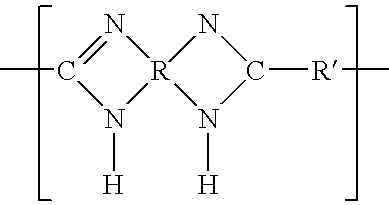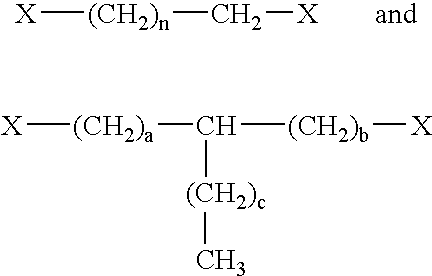Solvent-resistant microporous polybenzimidazole membranes and modules
a technology of microporous polybenzimidazole and polymer, which is applied in the field of solvent-resistant microporous polybenzimidazole membranes and modules, can solve the problems of inability to treat feed streams containing solvents or other harsh chemicals, polyimides are known to be susceptible to hydrolysis, and conventional polymers used for microporous membrane formation by solution precipitation are not resistant to solvents used to form polymer solutions for casting or spinning fabrication
- Summary
- Abstract
- Description
- Claims
- Application Information
AI Technical Summary
Benefits of technology
Problems solved by technology
Method used
Image
Examples
example 1
[0051]A fiber-spinning solution was prepared consisting of 18 wt % poly(2,2′-[m-phenylene])-5,5′bis-benzimidazole (Hoechst-Celanese, Charlotte, N.C.), 3 wt % PVP (K16–18, Acros Organics, New Jersey) (a high molecular weight pore former with a molecular weight of 8000 daltons), 22 wt % n-propanol (a low molecular weight pore-former with a molecular weight of 60 daltons), 0.4 wt % water and the balance DMAC. This solution was filtered through a 20 μm polypropylene filter while transferring the same to a reservoir held at a pressure of 25 inches of vacuum. The viscosity of the solution at 50° C. was 13,800 cp. The fiber-spinning solution was then extruded at a rate of 2 cm3 / min at 50° C. through a tube-in-orifice spinneret having an orifice diameter of 800 μm and a 27-gage tube using 100% IPA as the internal coagulation solution. The hollow fiber formed by this extrusion was drawn at a rate of 460 cm / min into a quench bath at 30° C. comprising 75 wt % IPA and 25 wt % methanol. The resu...
example 2
[0054]To test the solvent resistance of the fibers, crosslinked and uncrosslinked fiber samples from Example 1 were soaked for 72 hours in a solution of N-methyl pyrollidinone (NMP) at 100° C., which caused the uncrosslinked fibers to dissolve, and the crosslinked fibers to absorb NMP and swell, but-remain intact. As shown in Table 1, the crosslinked fibers maintained high strength (i.e., greater than 100 g / fil) and high elongation at break values. After drying the crosslinked fibers to remove NMP, their permeance to nitrogen was tested and shown to be the same as for the crosslinked fibers of Example 1 before exposure to the solvent and high temperature.
[0055]
TABLE 1Elongation atTensile StrengthBreakNitrogenExample No.(g / fil)(%)Permeance*1 (uncrosslinked)72020251 (crosslinked)92021452 (crosslinked)25075452 (uncrosslinked)DissolvedDissolved—*m3 / m2 · hr · atm
example 3
[0057]Hollow fiber membranes were prepared as in Example 1 with the following exceptions: the fiber-spinning solution was maintained at a temperature of 30° C., the viscosity of the fiber-spinning solution at 30° C. was 37,000 cp, and there was no crosslinking.
[0058]The resulting microporous hollow-fiber had an average internal diameter of 440 μm and an average wall thickness of 100 μm. The microporosity of the fibers was indicated by their high nitrogen permeance of 25 m3 / m2·hr·atm. The fibers had a tensile strength of 720 g / fil and an elongation at break of 20%.
PUM
| Property | Measurement | Unit |
|---|---|---|
| diameter | aaaaa | aaaaa |
| elongation at break | aaaaa | aaaaa |
| inner diameter | aaaaa | aaaaa |
Abstract
Description
Claims
Application Information
 Login to View More
Login to View More - R&D
- Intellectual Property
- Life Sciences
- Materials
- Tech Scout
- Unparalleled Data Quality
- Higher Quality Content
- 60% Fewer Hallucinations
Browse by: Latest US Patents, China's latest patents, Technical Efficacy Thesaurus, Application Domain, Technology Topic, Popular Technical Reports.
© 2025 PatSnap. All rights reserved.Legal|Privacy policy|Modern Slavery Act Transparency Statement|Sitemap|About US| Contact US: help@patsnap.com



